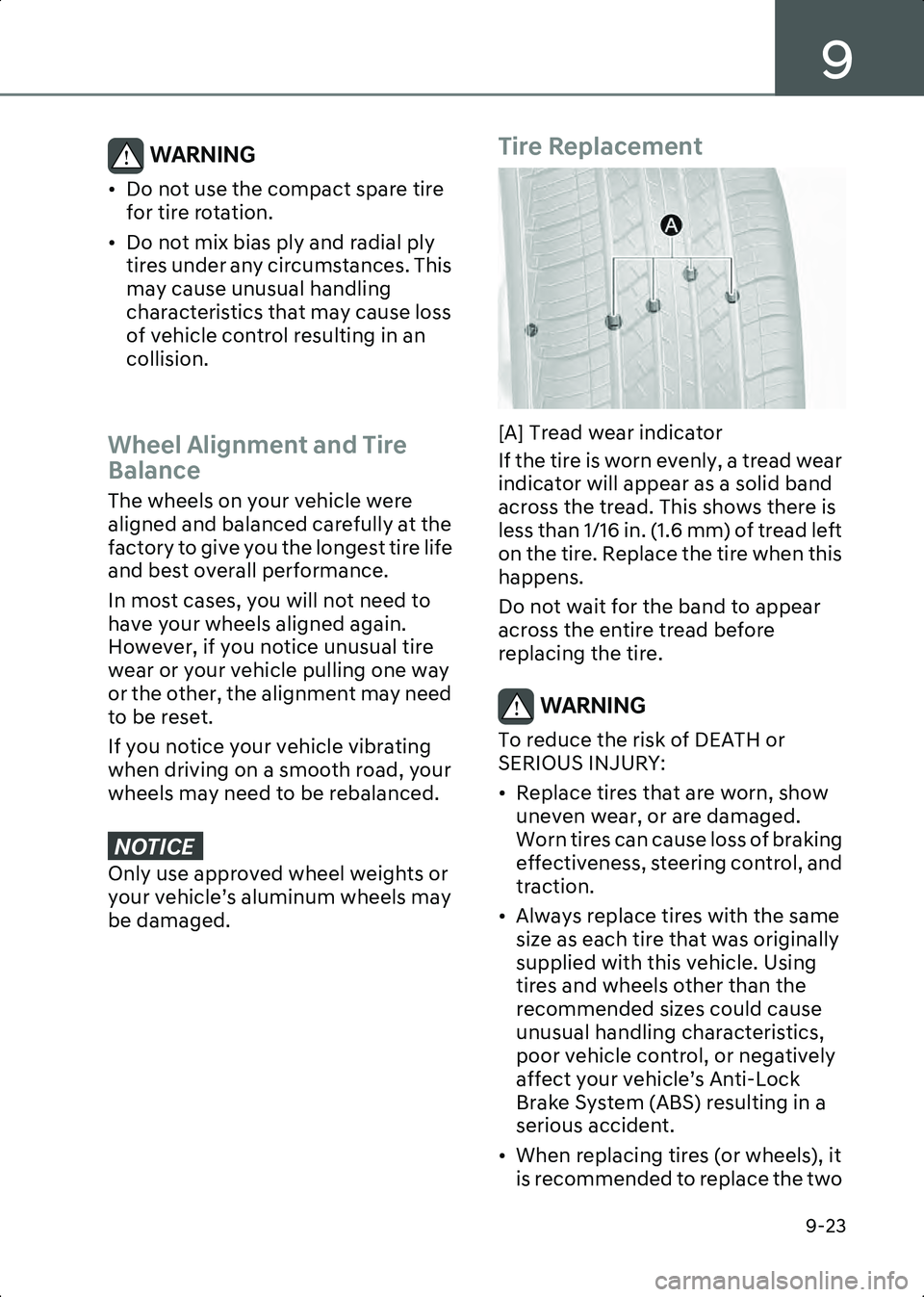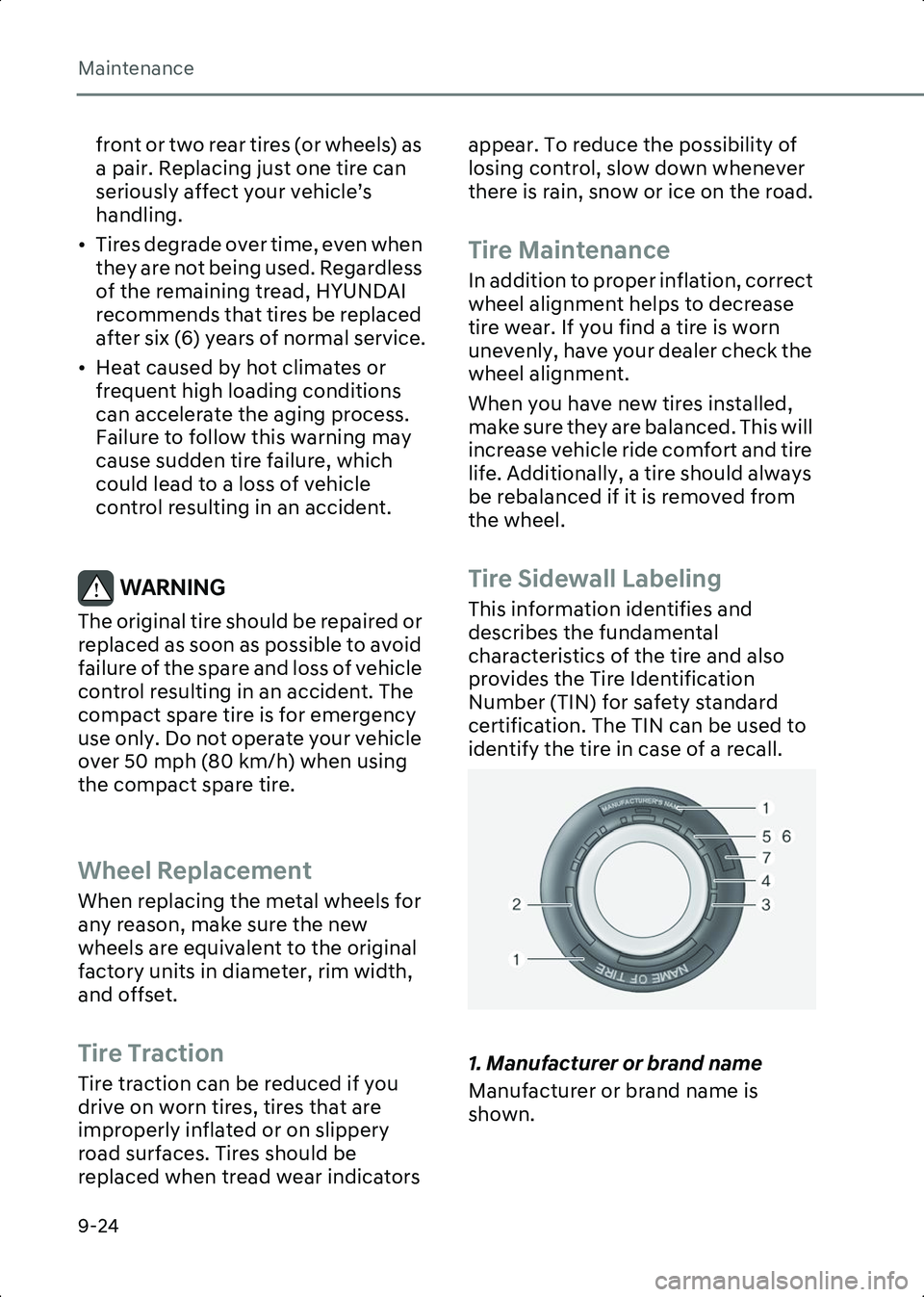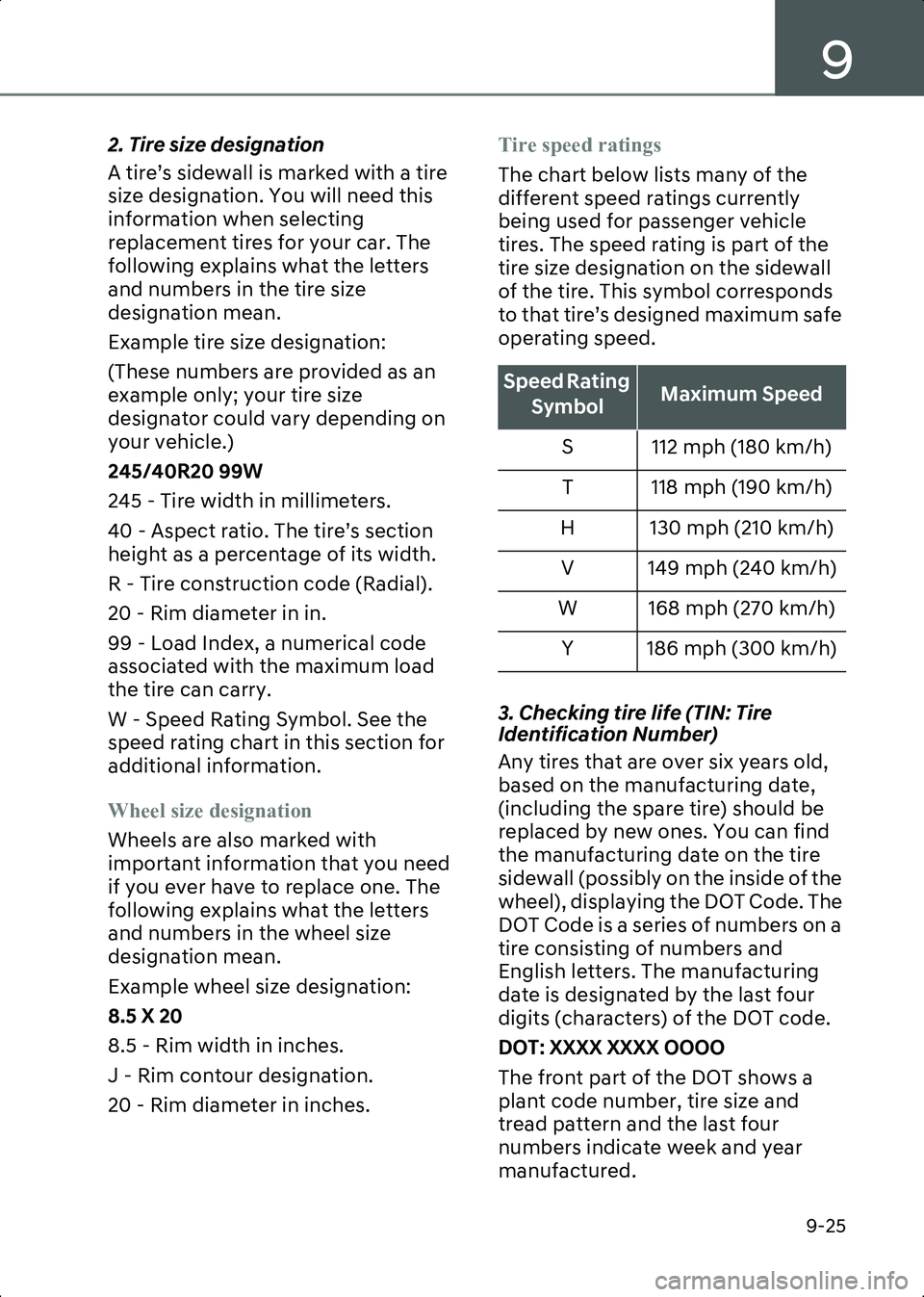Page 539 of 582

9
9-23
WARNING • Do not use the compact spare tire for tire rotation.
• Do not mix bias ply and radial ply tires under any circumstances. This
may cause unusual handling
characteristics that may cause loss
of vehicle control resulting in an
collision.
Wheel Alignment and Tire
Balance
The wheels on your vehicle were
aligned and balanced carefully at the
factory to give you the longest tire life
and best overall performance.
In most cases, you will not need to
have your wheels aligned again.
However, if you notice unusual tire
wear or your vehicle pulling one way
or the other, the alignment may need
to be reset.
If you notice your vehicle vibrating
when driving on a smooth road, your
wheels may need to be rebalanced.
NOTICE���2�Q�O�\���X�V�H���D�S�S�U�R�Y�H�G���Z�K�H�H�O���Z�H�L�J�K�W�V���R�U��
�\�R�X�U���Y�H�K�L�F�O�H�T�V���D�O�X�P�L�Q�X�P���Z�K�H�H�O�V���P�D�\��
�E�H���G�D�P�D�J�H�G��
��
Tire Replacement
B9005201[A] Tread wear indicator
If the tire is worn evenly, a tread wear
indicator will appear as a solid band
across the tread. This shows there is
less than 1/16 in. (1.6 mm) of tread left
on the tire. Replace the tire when this
happens.
Do not wait for the band to appear
across the entire tread before
replacing the tire.
WARNING To reduce the risk of DEATH or
SERIOUS INJURY:
• Replace tires that are worn, show uneven wear, or are damaged.
Worn tires can cause loss of braking
effectiveness, steering control, and
traction.
• Always replace tires with the same size as each tire that was originally
supplied with this vehicle. Using
tires and wheels other than the
recommended sizes could cause
unusual handling characteristics,
poor vehicle control, or negatively
affect your vehicle’s Anti-Lock
Brake System (ABS) resulting in a
serious accident.
• When replacing tires (or wheels), it is recommended to replace the two
Hyundai_CE_en_US.book Page 23
Page 540 of 582

Maintenance
9-24
front or two rear tires (or wheels) as
a pair. Replacing just one tire can
seriously affect your vehicle’s
handling.
• Tires degrade over time, even when they are not being used. Regardless
of the remaining tread, HYUNDAI
recommends that tires be replaced
after six (6) years of normal service.
• Heat caused by hot climates or frequent high loading conditions
can accelerate the aging process.
Failure to follow this warning may
cause sudden tire failure, which
could lead to a loss of vehicle
control resulting in an accident.
WARNING The original tire should be repaired or
replaced as soon as possible to avoid
failure of the spare and loss of vehicle
control resulting in an accident. The
compact spare tire is for emergency
use only. Do not operate your vehicle
over 50 mph (80 km/h) when using
the compact spare tire.
Wheel Replacement
When replacing the metal wheels for
any reason, make sure the new
wheels are equivalent to the original
factory units in diameter, rim width,
and offset.
Tire Traction
Tire traction can be reduced if you
drive on worn tires, tires that are
improperly inflated or on slippery
road surfaces. Tires should be
replaced when tread wear indicators appear. To reduce the possibility of
losing control, slow down whenever
there is rain, snow or ice on the road.
Tire Maintenance
In addition to proper inflation, correct
wheel alignment helps to decrease
tire wear. If you find a tire is worn
unevenly, have your dealer check the
wheel alignment.
When you have new tires installed,
make sure they are balanced. This will
increase vehicle ride comfort and tire
life. Additionally, a tire should always
be rebalanced if it is removed from
the wheel.
Tire Sidewall Labeling
This information identifies and
describes the fundamental
characteristics of the tire and also
provides the Tire Identification
Number (TIN) for safety standard
certification. The TIN can be used to
identify the tire in case of a recall.
B9005401
1. Manufacturer or brand name
Manufacturer or brand name is
shown.
Hyundai_CE_en_US.book Page 24
Page 541 of 582

9
9-25
2. Tire size designation
A tire’s sidewall is marked with a tire
size designation. You will need this
information when selecting
replacement tires for your car. The
following explains what the letters
and numbers in the tire size
designation mean.
Example tire size designation:
(These numbers are provided as an
example only; your tire size
designator could vary depending on
your vehicle.)
245/40R20 99W
245 - Tire width in millimeters.
40 - Aspect ratio. The tire’s section
height as a percentage of its width.
R - Tire construction code (Radial).
20 - Rim diameter in in.
99 - Load Index, a numerical code
associated with the maximum load
the tire can carry.
W - Speed Rating Symbol. See the
speed rating chart in this section for
additional information.
Wheel size designation
Wheels are also marked with
important information that you need
if you ever have to replace one. The
following explains what the letters
and numbers in the wheel size
designation mean.
Example wheel size designation:
8.5 X 20
8.5 - Rim width in inches.
J - Rim contour designation.
20 - Rim diameter in inches.Tire speed ratings
The chart below lists many of the
different speed ratings currently
being used for passenger vehicle
tires. The speed rating is part of the
tire size designation on the sidewall
of the tire. This symbol corresponds
to that tire’s designed maximum safe
operating speed.
3. Checking tire life (TIN: Tire
Identification Number)
Any tires that are over six years old,
based on the manufacturing date,
(including the spare tire) should be
replaced by new ones. You can find
the manufacturing date on the tire
sidewall (possibly on the inside of the
wheel), displaying the DOT Code. The
DOT Code is a series of numbers on a
tire consisting of numbers and
English letters. The manufacturing
date is designated by the last four
digits (characters) of the DOT code.
DOT: XXXX XXXX OOOO
The front part of the DOT shows a
plant code number, tire size and
tread pattern and the last four
numbers indicate week and year
manufactured.
Speed Rating
SymbolMaximum Speed
S 112 mph (180 km/h) T 118 mph (190 km/h)
H 130 mph (210 km/h) V 149 mph (240 km/h)
W 168 mph (270 km/h) Y 186 mph (300 km/h)
Hyundai_CE_en_US.book Page 25